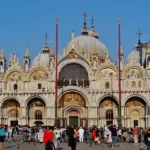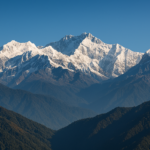
In the heart of Mali, Africa, rises the Great Mosque of Djenné. This awe-inspiring structure isn’t just any mosque – it’s the largest building in the world constructed entirely of mudbrick! Its unique design and cultural significance make it a true architectural marvel.
The Great Mosque of Djenné, situated in Mali, holds the prestigious title of being the largest mud-brick building globally, boasting a remarkable architectural feat. Constructed in the 13th century, this historic structure has undergone multiple reconstructions over the years due to the harsh effects of the rainy season on its sun-baked mud brick walls and palm tree wood supports. Its sheer size and intricate design make it a standout landmark, drawing admiration from visitors worldwide.
Rising to prominence in the 13th century, the Great Mosque of Djenné has stood the test of time, undergoing various renovations to maintain its grandeur. The mosque’s rich history and cultural significance are deeply rooted in its origins, reflecting the architectural prowess of its builders. The continuous efforts to preserve and restore this ancient marvel highlight its enduring legacy and importance to the local community.
The Great Mosque of Djenné’s walls, crafted from sun-baked mud bricks and reinforced with palm tree wood, contribute to its distinctive appearance and structural integrity. The use of traditional building materials adds to the mosque’s authenticity and showcases the craftsmanship of its creators. This unique blend of natural elements gives the mosque a timeless appeal that captivates all who behold its beauty.
Standing tall at approximately 16 meters, the adobe minarets of the Great Mosque of Djenné command attention with their impressive height and architectural finesse. These towering structures serve as iconic features of the mosque, symbolizing spiritual significance and cultural heritage. The minarets’ grandeur adds to the mosque’s overall magnificence, making it a sight to behold for visitors and worshippers alike.
The Great Mosque of Djenné’s construction is a collaborative effort that unites the local community in a yearly maintenance festival known as “Crépissage.” This communal gathering underscores the mosque’s importance as a cultural and religious hub, where residents come together to preserve and protect this architectural gem. The tradition of Crépissage not only ensures the mosque’s structural integrity but also strengthens the bond among community members, fostering a sense of shared heritage and pride.
The design of the Great Mosque of Djenné features three imposing towers, with one housing the mihrab, a niche indicating the direction of Mecca for prayer. This architectural detail holds significant religious symbolism for worshippers, guiding them in their daily prayers and spiritual connection. The strategic placement of the mihrab within the mosque’s structure reflects meticulous planning and reverence for Islamic traditions, enhancing the mosque’s sacred ambiance.
The Great Mosque of Djenné’s recognition as a UNESCO World Heritage Site in 1988 underscores its exceptional cultural and architectural value on a global scale. This prestigious designation acknowledges the mosque’s historical significance and unique construction, solidifying its status as a treasured landmark. The UNESCO recognition highlights the importance of preserving and celebrating Djenné’s mosque as a testament to human ingenuity and artistic expression.
The interior of the Great Mosque of Djenné can accommodate up to 3,000 worshippers during religious gatherings, emphasizing its role as a communal space for spiritual reflection and prayer. The vast prayer hall provides a welcoming environment for worshippers to come together and participate in religious ceremonies, fostering a sense of unity and devotion. The mosque’s capacity to host large congregations speaks to its significance as a place of worship and community bonding.
Elevated on a raised platform to protect it from flooding during the rainy season, the Great Mosque of Djenné demonstrates thoughtful architectural planning and adaptation to its natural surroundings. This strategic design feature safeguards the mosque from potential water damage, ensuring its longevity and structural stability. The raised platform not only serves a practical purpose but also enhances the mosque’s visual appeal, setting it apart as a resilient and well-preserved architectural marvel.
The Great Mosque of Djenné’s walls are adorned with wooden beams that protrude from the surface, creating a visually striking pattern that adds to the mosque’s aesthetic charm. The intricate design of the wooden beams showcases the skilled craftsmanship of the builders, who meticulously crafted each element to enhance the mosque’s overall beauty. This decorative feature lends a sense of texture and depth to the mosque’s exterior, making it a captivating sight for visitors and a testament to the artistic ingenuity of its creators.
The Great Mosque of Djenné’s central prayer hall is supported by an impressive array of 90 large wooden pillars, each intricately carved with geometric designs. These pillars not only provide structural support but also serve as decorative elements that showcase the craftsmanship and artistry of the builders. The intricate carvings on the wooden pillars add a touch of elegance to the mosque’s interior, creating a serene and visually captivating space for worshippers.
Constructed using a combination of earth, water, and organic materials such as millet, shea butter, and baobab leaves, the Great Mosque of Djenné embodies a harmonious blend of natural elements. The incorporation of locally sourced materials reflects the sustainable building practices of the region and highlights the resourcefulness of the builders. By utilizing indigenous resources in its construction, the mosque pays homage to the environment and cultural heritage of Djenné.
The Great Mosque of Djenné’s walls are coated with a mixture of mud and clay, creating a smooth and reddish-brown finish that enhances its visual appeal. The application of mud and clay plaster not only adds a layer of protection to the walls but also gives the mosque a distinct earthy hue that harmonizes with its surroundings. This traditional building technique contributes to the mosque’s authenticity and timeless beauty, showcasing the enduring allure of mud-brick architecture.
The annual maintenance festival known as “Crépissage” involves the re-plastering of the Great Mosque of Djenné’s walls to preserve its structural integrity and aesthetic charm. This communal effort underscores the importance of ongoing maintenance and care to ensure the longevity of the mosque. The tradition of Crépissage serves as a reminder of the community’s dedication to safeguarding this architectural treasure for future generations, fostering a sense of pride and stewardship among residents.
The Great Mosque of Djenné stands as a prime example of Sudano-Sahelian architecture, blending Islamic design principles with local building traditions. This architectural style is characterized by its use of mud-brick construction, large wooden pillars, and intricate geometric patterns. The fusion of Islamic and indigenous architectural elements in the mosque’s design reflects the cultural diversity and artistic heritage of the region, making it a symbol of cultural exchange and creativity.
The Great Mosque of Djenné incorporates traditional West African architectural elements such as toron pillars and wooden beams, adding a distinctive flair to its design. These architectural features are symbolic of the region’s cultural identity and craftsmanship, showcasing the unique artistic traditions of Djenné. The intricate detailing of the toron pillars and wooden beams highlights the skill and artistry of the builders, creating a visually stunning and culturally rich architectural masterpiece.
Serving as a focal point for the local community, the Great Mosque of Djenné plays a vital role in hosting religious and social events that bring residents together. The mosque serves as a gathering place for worshippers to participate in daily prayers, religious ceremonies, and community celebrations. Its central location and cultural significance make it a hub of activity and connection, fostering a sense of unity and belonging among the people of Djenné.
The construction of the Great Mosque of Djenné is overseen by a dedicated group of masons and craftsmen who specialize in traditional building techniques. These skilled artisans work tirelessly to maintain the mosque’s structural integrity and architectural beauty, employing age-old methods passed down through generations. Their expertise and craftsmanship are essential in preserving the authenticity and historical value of Djenné’s mosque, ensuring that it remains a cherished cultural landmark for years to come.
Adorned with intricate geometric patterns and designs on its exterior walls, the Great Mosque of Djenné showcases the region’s rich artistic heritage and craftsmanship. The elaborate motifs and detailing reflect the cultural significance and aesthetic beauty of the mosque, captivating visitors with their mesmerizing complexity. The geometric patterns not only enhance the visual appeal of the mosque but also serve as a testament to the skill and creativity of the builders who crafted them with precision and care.
The annual maintenance festival known as “Crépissage” involves the re-plastering of the Great Mosque of Djenné’s walls to uphold its structural integrity and preserve its historical significance. This communal tradition highlights the community’s commitment to maintaining and protecting this architectural gem, ensuring that it remains a symbol of cultural pride and heritage. The practice of Crépissage serves as a reminder of the mosque’s enduring legacy and the collective effort required to safeguard its beauty and authenticity for future generations.
The Great Mosque of Djenné stands as a testament to the enduring legacy of African architecture and craftsmanship, showcasing the region’s rich cultural heritage and artistic expression. Its construction techniques, passed down through generations, preserve traditional building methods and highlight the skill and ingenuity of the builders.
The minarets of the Great Mosque of Djenné are topped with ostrich eggs, symbolizing fertility and purity in local folklore. This unique architectural detail adds a touch of symbolism and cultural significance to the mosque, reflecting the traditions and beliefs of the community.
Serving as a spiritual center for the local Muslim community, the Great Mosque of Djenné hosts daily prayers and religious ceremonies, providing a sacred space for worship and reflection. Its significance as a place of spiritual connection and communal gathering underscores its importance in the lives of residents.
The architecture of the Great Mosque of Djenné is designed to provide natural ventilation and cooling, utilizing local materials to adapt to the climate. This thoughtful design feature enhances the mosque’s comfort and functionality, creating a harmonious environment for worshippers and visitors.
Djenné’s mosque attracts visitors from around the world to admire its beauty and historical significance, serving as a cultural landmark that celebrates the region’s architectural heritage. Its status as a symbol of cultural pride and identity highlights its importance as a cherished treasure that continues to inspire awe and admiration among those who experience its magnificence.
FAQs about the Great Mosque of Djenné
The Great Mosque of Djenné is a truly fascinating landmark, so here are some frequently asked questions to quench your curiosity:
1. What is the Great Mosque of Djenné?
The Great Mosque of Djenné, also known as the Djenné Grand Mosque, is a large adobe mosque located in the city of Djenné, Mali. Made entirely of sun-baked mudbrick, it holds the title of the largest mudbrick building in the world! The mosque serves as a central place of worship for the people of Djenné and is a significant landmark in Sudano-Sahelian architecture, a style combining elements from West African and Islamic traditions.
2. When was the Great Mosque built?
There’s a bit of history here! The first mosque on the site is believed to have been built around the 13th century. However, the current structure we see today dates from 1907. Throughout the centuries, the mosque has undergone renovations and repairs, but the overall design has remained remarkably consistent.
3. What is the Great Mosque made of?
The mosque is constructed primarily from mudbrick. Locally made sun-baked bricks, called ” banco,” form the walls and supporting structures. Timber plays a crucial role too, with numerous wooden pillars supporting the massive earthen roof. Interestingly, the roof features removable terracotta ceramic lids. These lids allow for ventilation during the day and can be closed at night to retain warmth.
4. Why is the Great Mosque shaped the way it is?
The mosque has a unique trapezoidal form, with walls that are not perfectly perpendicular. This specific design is believed to be intentional and serves two purposes. Firstly, the sloping walls help to shed rainwater effectively, crucial in the region’s wet season. Secondly, the leaning walls add a sense of monumentality and grandeur to the structure.
5. What are the minarets like?
The Great Mosque boasts three large, square minarets that jut out from the qibla (prayer wall) facing east towards Mecca. The central minaret is the tallest, reaching a height of 52 feet. Unlike traditional minarets used for the Muslim call to prayer, the minarets of the Great Mosque are purely symbolic and do not have internal staircases.
6. Is the plastering a permanent feature?
The exterior of the Great Mosque is covered in a thick layer of plaster, giving it a smooth, almost sculpted appearance. This plastering is not just for aesthetics! It serves a vital purpose by protecting the mudbrick walls from erosion during the rainy season. The plastering is a community effort, with a unique annual festival held to re-coat the mosque in fresh plaster.
7. What is the significance of the Great Mosque?
Beyond its architectural marvel, the Great Mosque holds immense cultural and religious significance for the people of Djenné. It serves as the heart of the community, a place for worship, social gatherings, and education. Its towering presence is a symbol of Islamic faith and a testament to the traditional building techniques of the region. In 1988, UNESCO recognized the Great Mosque of Djenné, along with the Old Towns of Djenné, as a World Heritage Site.









